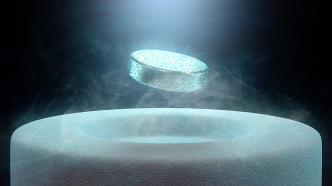
The "illusion" of room-temperature superconductivity that Ranga Dias had worked so hard to create was finally shattered.
Following the release of the investigation report on the Dias fraud scandal in March, on April 6, Nature published another long article detailing the details of the official investigation by the University of Rochester into his academic misconduct allegations.
The 124-page official report shows that Dias, a physicist at the University of Rochester, is suspected of data fraud, tampering, and plagiarism. The official investigation lasted 10 months and was conducted by an independent team of scientists recruited by the University of Rochester. The investigation was completed on February 8. The investigation team reviewed 16 allegations against Dias and concluded that in each case, he was likely to have committed academic misconduct.
The University of Rochester, where Dias holds tenure, is seeking to fire him before his contract ends in the 2024-2025 academic year.
Three investigations failed
The investigation report lists Dias' fraudulent behavior in his academic career, including two room-temperature superconductivity studies he published in Nature, and two other papers published in Chemical Communications and Physical Review Letters (PRL). All of these articles have been retracted. Documents submitted by the University of Rochester to the court show that the investigation was conducted at the request of the National Science Foundation (NSF).
NSF is the main funding agency for academic research in the United States. In 2021, the agency awarded Dias the Faculty Early Career Development Program (CAREER) Award in the amount of $790,000.
It is worth noting that this NSF-supported investigation is not the first time that the University of Rochester has investigated possible problems in Dias' laboratory. Between 2021 and 2022, the university conducted three preliminary investigations into Dias's carbon sulfur hydride (CSH) room-temperature superconducting paper published in Nature, but all ended in Dias' victory.
The law is long and wide, nothing can escape it
In October 2022, James Hamlin, a physicist at the University of Florida, expressed his concerns about Dias' work to the NSF.
The University of Rochester formed an investigative committee of three physicists to ensure the credibility of the investigation: Marius Millot and Peter Celliers of Lawrence Livermore National Laboratory, and Marcus Knudson of Sandia National Laboratories.
The investigative report showed that Dias forged the CSH data and published it. When the source of the data was scrutinized, Dias and his collaborator and co-author, Ashkan Salamat, a physicist at the University of Nevada, Las Vegas (UNLV), released a set of fabricated original data.
Questions about the discrepancies between the original and published data continued to arise, so Dias claimed that a complex data processing method was used to publish the data. This practice focused critics' attention on the data processing technology rather than the original data, providing a "plausible illusion."
The investigation report also showed that Dias had promised to provide raw data on several occasions but never did so. In his response to the investigation's findings, he wrote: "The absence of certain raw data files does not mean that they do not exist, nor does it indicate any wrongdoing on my part."
Dias repeatedly and intentionally misled team members and collaborators about the origin of their data. He told UNLV partners that measurements were made at the University of Rochester and, in turn, told Rochester researchers that measurements were made at UNLV, the report showed.
Dias also lied to the journal. The paper retracted by PRL, a study on the electrical properties of manganese disulfide (MnS2), was found by the journal to have obvious data fabrication. He provided the journal reviewer with fabricated data instead of the original data, and was found by PRL to have "deliberately obstructed the review." Investigators commissioned by the University of Rochester confirmed the journal's findings that Dias used the resistance data of germanium tetraselenide in his doctoral thesis for the study of manganese disulfide, which is a completely different material. When the investigators asked about this, Dias sent them the same fabricated data that he sent to PRL.
Exactly how Dias fiddled with data became clearest in the findings of the LuH paper. Dias’s former students helped the committee track down the raw data on the lab’s hard drive. According to the raw data, Dias often selectively omitted data “to mask erratic dips and jumps in the resistance data that contradicted the view of LuH’s superconducting behavior,” the committee wrote.
The investigative committee found that on August 27, 2022, Sachith Dissanayake, a co-author who was working with Dias at the University of Rochester at the time, warned Dias that the research data had been improperly manipulated, but Dias ignored his warnings. In his response to the investigative report, he claimed that Dissanayake had misinterpreted the data.
These tampered data were the key to LuH's paper being accepted.
Case closed
On December 22, 2023, the investigation committee sent a draft report to Dias, who attacked the investigators' expertise and integrity. He claimed that the investigators' methods "can sometimes be seen in the field of conspiracy theories" and "lack a strong logical basis." Dias also claimed that Salamat persuaded Dias' former students to oppose him and write to Nature to withdraw LuH's research paper. However, the opposite is true. Nature's news team previously reported that it was the students who took the initiative to report and send the withdrawal request letter.
In his response, Dias did not provide the raw data requested by the investigative committee. In their final report, investigators responded to Dias' allegations, saying the explanation for the omission of his data did not change the investigative committee's reasoning or findings.
Ultimately, the panel determined that the Rochester students and Dissanayake were not culprits, but rather victims. The panel did not have access to UNLV resources to exonerate the researchers, including Salamat, but concluded that they were also deceived and found no "substantial evidence of wrongdoing." The panel recommended that Dias should not be allowed to continue teaching or conducting publicly or privately funded research. "The evidence uncovered in this investigation demonstrates that Dias cannot be trusted," they added.


